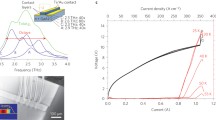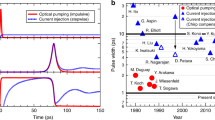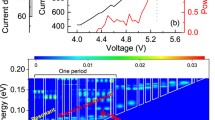Abstract
The fundamental mechanism behind laser action leads in general only to narrowband, single-wavelength emission. Several approaches for achieving spectrally broadband laser action have been put forward, such as enhancing the optical feedback in the wings of the gain spectrum1,2, multi-peaked gain spectra3,4, and the most favoured technique at present, ultrashort pulse excitation5,6. Each of these approaches has drawbacks, such as a complex external laser cavity configuration, a non-flat optical gain envelope function, or an inability to operate in continuous mode, respectively. Here we present a monolithic, mid-infrared ‘supercontinuum’ semiconductor laser that has none of these drawbacks. We adopt a quantum cascade7,8 configuration, where a number of dissimilar intersubband optical transitions are made to cooperate in order to provide broadband optical gain from 5 to 8 µm wavelength. Laser action with a Fabry–Pérot spectrum covering all wavelengths from 6 to 8 µm simultaneously is demonstrated with this approach. Lasers that emit light over such an extremely wide wavelength range are of interest for applications as varied as terabit optical data communications9 or ultra-precision metrology10 and spectroscopy11.




Similar content being viewed by others
References
Mittelstein, M. et al. Broadband tunability of gain-flattened quantum well semiconductor lasers with an external grating. Appl. Phys. Lett. 54, 1092–1094 (1989).
Hall, D. C. et al. Broadband long-wavelength operation (9700 Å ≥ λ ≥ 8700 Å) of AlyGa1-yAs-GaAs-InxGa1-xAs quantum well heterostructure lasers in an external grating cavity. Appl. Phys. Lett. 55, 752–754 (1989).
Chernikov, S. V. et al. Supercontinuum self-Q-switched ytterbium fiber laser. Opt. Lett. 22, 298–300 (1997).
Fuke, A., Masuda, K. & Tokita, Y. High power He-Cd+ white light laser. AIP Conf. Proc. 160, 229–231 (1987).
Spielmann, C. et al. Ultrabroadband femtosecond lasers. IEEE J. Quantum Electron. 30, 1100–1114 (1994).
Ranka, J. K., Windeler, R. S. & Stentz, A. J. Visible continuum generation in air silica microstructure optical fibers with anomalous dispersion at 800nm. Opt. Lett. 25, 25–27 (2000).
Capasso, F. et al. New frontiers in quantum cascade lasers and applications. IEEE J. Select. Topics Quantum Electron. 6, 931–947 (2000).
Gmachl, C., Capasso, F., Sivco, D. L. & Cho, A. Y. Recent progress in quantum cascade lasers and applications. Rep. Prog. Phys. 64, 1533–1601 (2001).
Collings, B. C., Mitchell, M. L., Boivin, L. & Knox, W. H. A 1021 channel WDM system. Opt. Photon. News 11, 31–35 (2000).
Jones, D. J. et al. Carrier-envelope phase control of femtosecond mode-locked lasers and direct optical frequency synthesis. Science 288, 635–639 (2000).
Schiff, H. I., Mackay, G. I. & Bechara, J. in Air Monitoring by Spectroscopic Techniques (ed. Sigrist, M. W.) Ch. 5, 239–333 (Wiley Interscience, New York, 1994).
Campman, K. L., Schmidt, H., Imamoglu, A. & Gossard, A. C. Interface roughness and alloy-disorder scattering contributions to intersubband transition linewidths. Appl. Phys. Lett. 69, 2554–2556 (1996).
Capasso, F. Band-gap engineering: from physics and materials to new semiconductor devices. Science 235, 172–176 (1987).
Muravjov, A. V., Withers, S. H., Pavlov, S. G., Shastin, V. N. & Peale, R. N. Broad band p-Ge optical amplifier of terahertz radiation. J. Appl. Phys. 86, 3512–3515 (1999).
Faist, J. et al. Quantum cascade laser. Science 264, 553–556 (1994).
Cho, A. Y. (ed.) Molecular Beam Epitaxy (AIP Press, Woodbury, New York, 1994).
Sirtori, C. et al. Quantum cascade laser with plasmon-enhanced waveguide operating at 8.4 µm wavelength. Appl. Phys. Lett. 66, 3242–3244 (1995).
Gmachl, C. et al. Quantum cascade lasers with a heterogeneous cascade: Two-wavelength operation. Appl. Phys. Lett. 79, 572–574 (2001).
Faist, J. et al. High-power mid-infrared (λ ∼ 5 µm) quantum cascade lasers operating above room temperature. Appl. Phys. Lett. 68, 3680–3682 (1996).
Acknowledgements
We thank S. N. G. Chu for help with material characterization, in particular transmission electron microscopy; T. S. Mosely and A. Straub for help with measurements; and D. A. Ackerman for discussions. This work was supported in part by DARPA/US Army Research Office.
Author information
Authors and Affiliations
Corresponding author
Ethics declarations
Competing interests
The authors declare no competing financial interests.
Rights and permissions
About this article
Cite this article
Gmachl, C., Sivco, D., Colombelli, R. et al. Ultra-broadband semiconductor laser. Nature 415, 883–887 (2002). https://doi.org/10.1038/415883a
Received:
Accepted:
Issue Date:
DOI: https://doi.org/10.1038/415883a
- Springer Nature Limited
This article is cited by
-
Compact ultrabroadband light-emitting diodes based on lanthanide-doped lead-free double perovskites
Light: Science & Applications (2022)
-
Dual-wavelength DFB quantum cascade lasers: sources for multi-species trace gas spectroscopy
Applied Physics B (2018)
-
Homogeneous spectral spanning of terahertz semiconductor lasers with radio frequency modulation
Scientific Reports (2017)
-
Selective doping of Ni2+ in highly transparent glass-ceramics containing nano-spinels ZnGa2O4 and Zn1+x Ga2−2x Ge x O4 for broadband near-infrared fiber amplifiers
Scientific Reports (2017)
-
Near-infrared and mid-infrared semiconductor broadband light emitters
Light: Science & Applications (2017)





